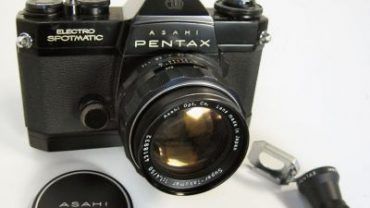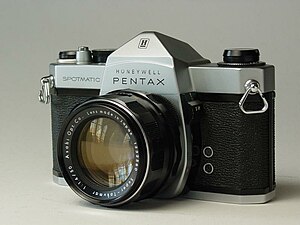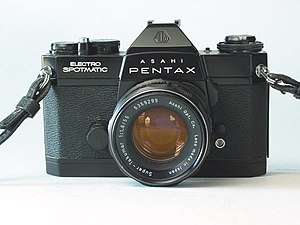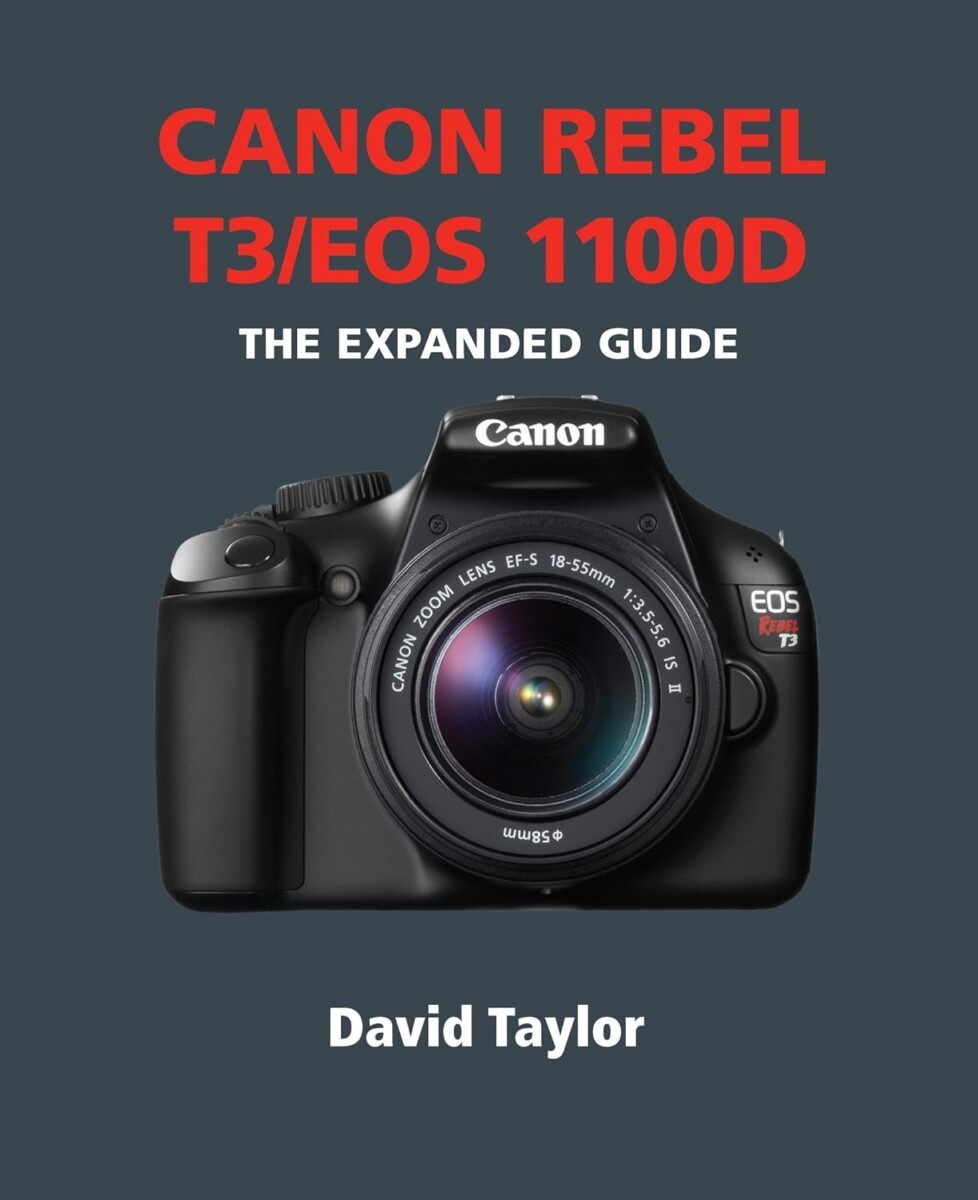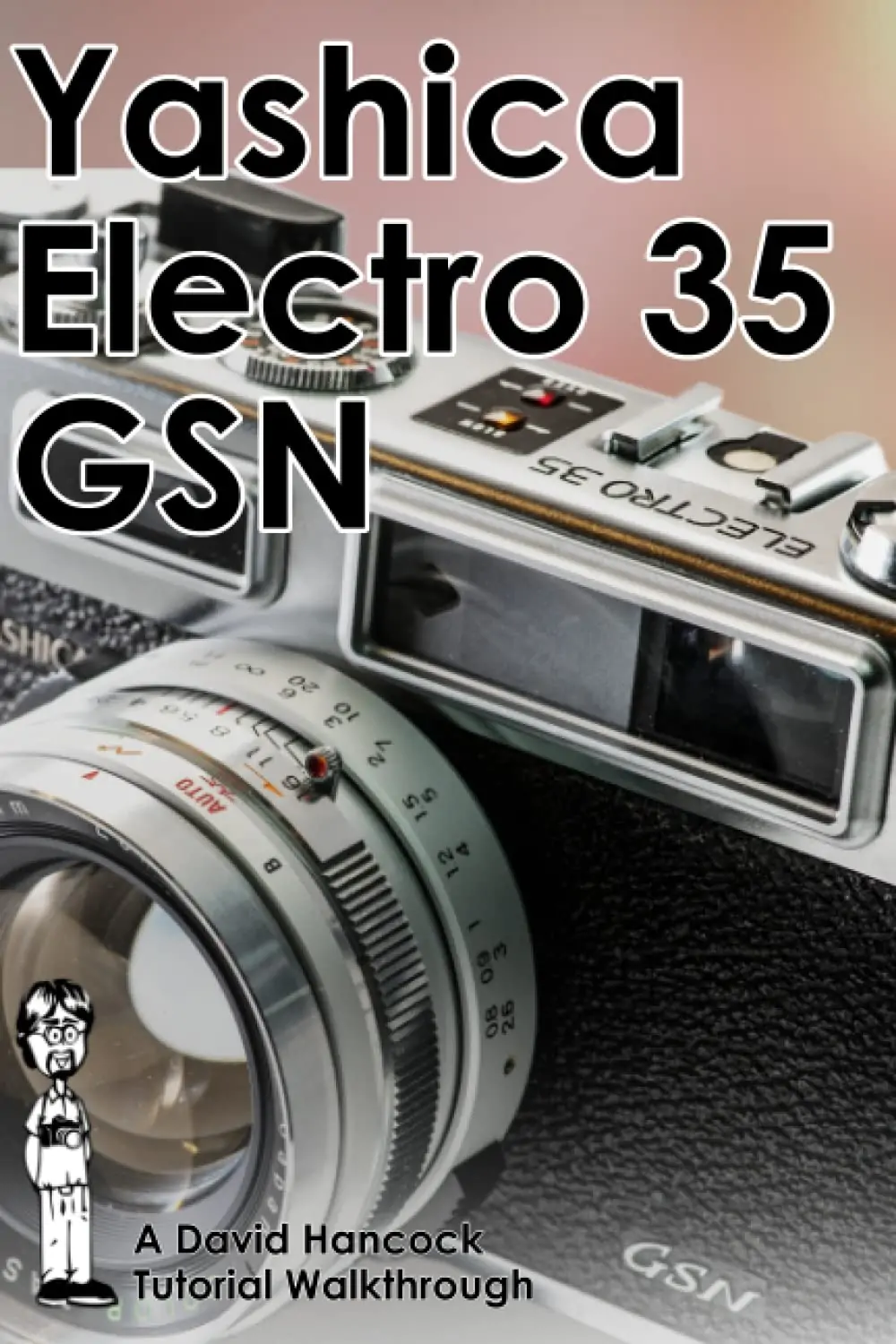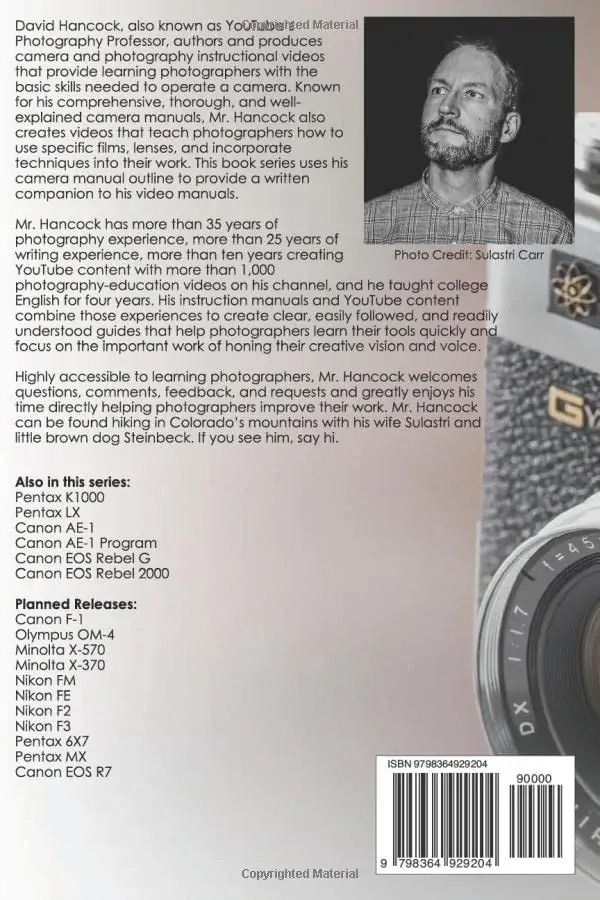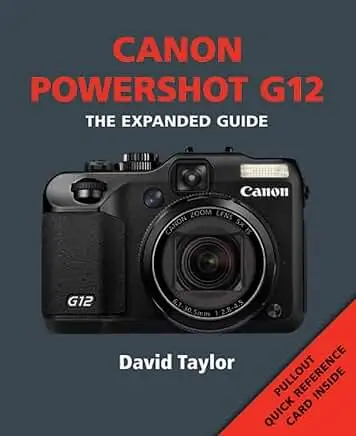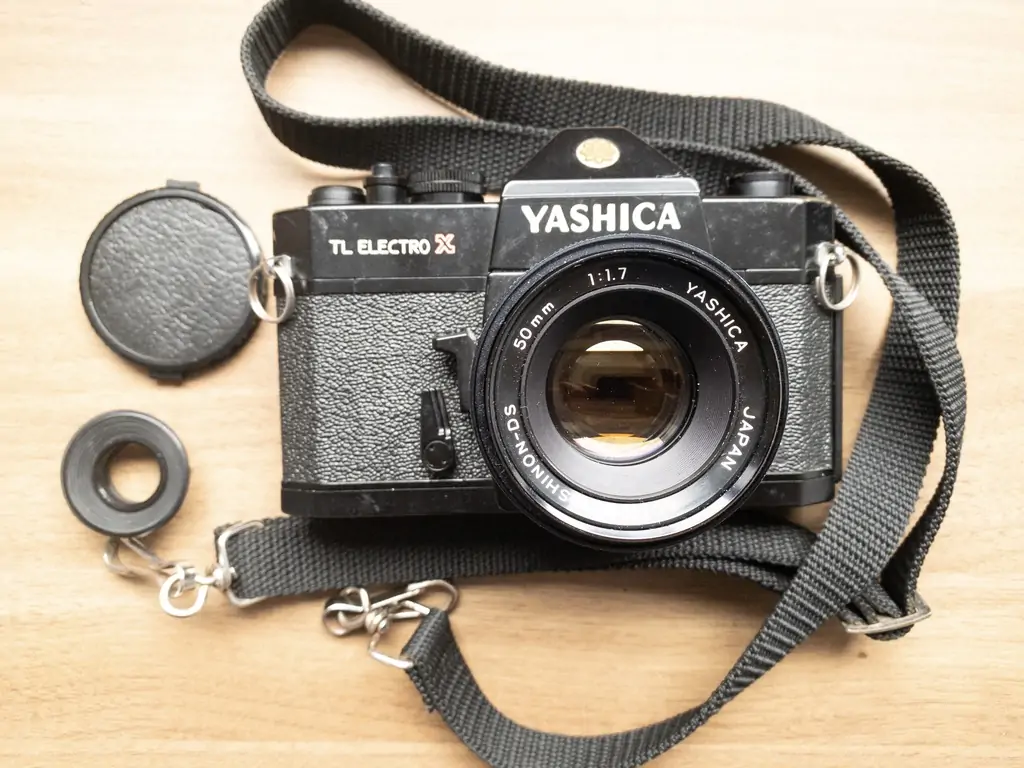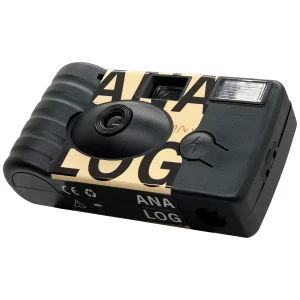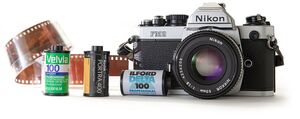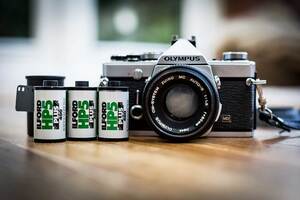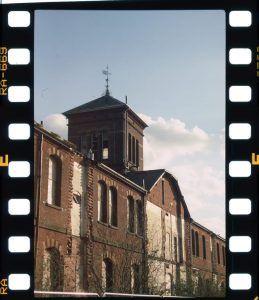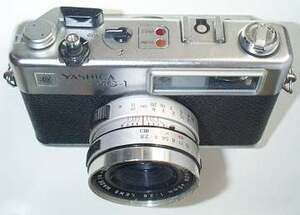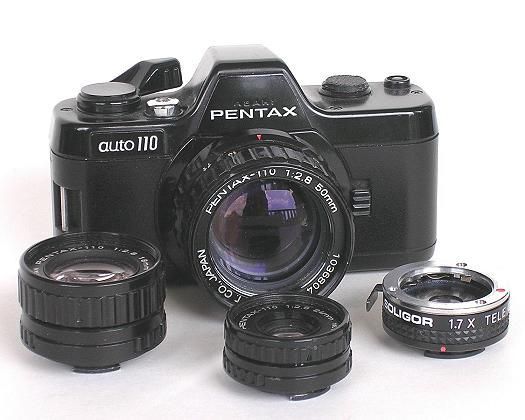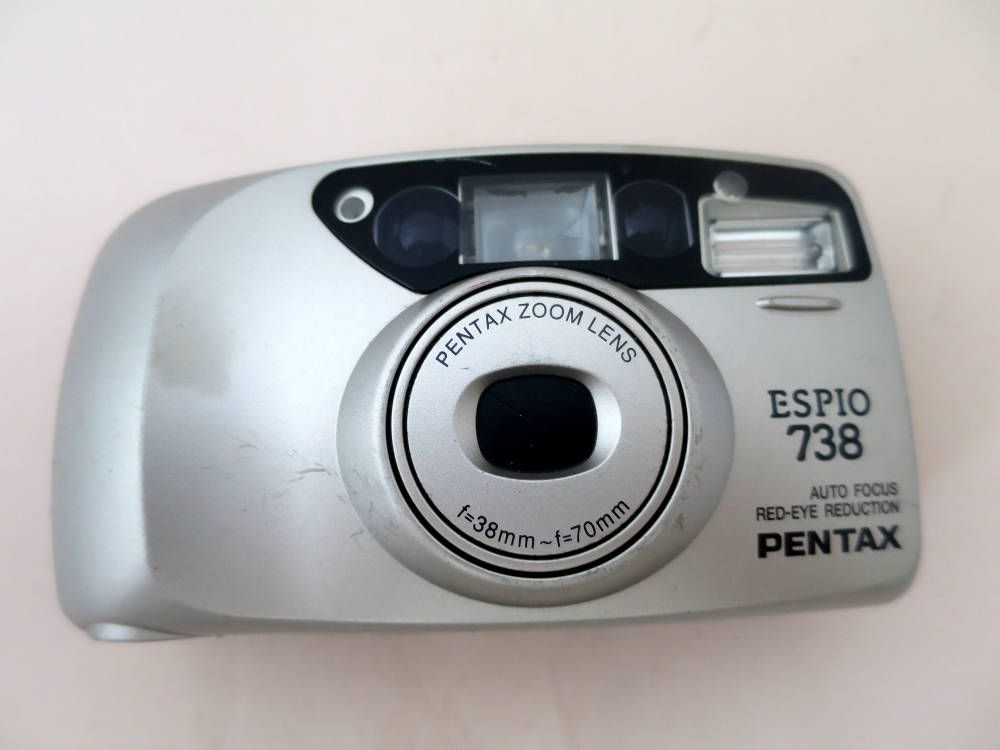On This Page
Overview
The PentaxPentax is a brand name used primarily by Japanese multinational imaging and electronics company Ricoh for 35mm cameras, sport optics, and CCTV optics. Not to be confused with Pentax 6×7 (1969 to 1990) and Pentax 67 (1990 to 1999) which were primarily used for the medium format 120 6x7cm cameras. The Pentax brand is also used by Hoya Corporation for medical products & services, TI Asahi for surveying instruments, and Seiko Optical Products for certain optical lenses. More Electro Spotmatic was the world's first 35mm SLRA single-lens reflex camera (SLR) is a camera that typically uses a mirror and prism system (hence "reflex" from the mirror's reflection) that permits the photographer to view through the lens and see exactly what will be captured. With twin lens reflex and rangefinder cameras, the viewed image could be significantly different from the final image. When the shutter button is pressed on most SLRs, the mirror flips out of the light path, allowing light to pass through to the film. Other camera typoes include DSLR, Rangefinder and Compact. More with a fully electronic shutterEither mechanical and/or electronic shutters are possible. Mechanical systems can use a leaf (or iris) shutter or curtain shutter. In digital cameras a third alternative is also possible: the electronic shutter. This works by activating and then deactivating the CCD so that no further light can be recorded, regardless of whether light is hitting the CCD. The shutter controls the exposure time, which can range from thousandths of a second to several minutes or more. Fast shutter speeds freeze action, slow speeds are more suited to stationary subjects. A tripod is recommended for slow exposure shots to avoid camera shake. More system. It was released in 1971 and only sold in Japan. The circuitry was under constant revision during the year of its release which arguably made the camera a prototype, which was evident due to reliability issues.
Its success was followed by the ES sold internationally from 1972. The ES had improved circuitry that addressed reliability issues in the original version. Two years later it was followed by the ES II. Special models were available with accessories such as Motor Drive and Data Back.
Features and Operation
The Electro is one of the hardest-to-find PentaxPentax is a brand name used primarily by Japanese multinational imaging and electronics company Ricoh for 35mm cameras, sport optics, and CCTV optics. Not to be confused with Pentax 6×7 (1969 to 1990) and Pentax 67 (1990 to 1999) which were primarily used for the medium format 120 6x7cm cameras. The Pentax brand is also used by Hoya Corporation for medical products & services, TI Asahi for surveying instruments, and Seiko Optical Products for certain optical lenses. More bodies in working condition. The photographer can choose between manual or automatic shutterEither mechanical and/or electronic shutters are possible. Mechanical systems can use a leaf (or iris) shutter or curtain shutter. In digital cameras a third alternative is also possible: the electronic shutter. This works by activating and then deactivating the CCD so that no further light can be recorded, regardless of whether light is hitting the CCD. The shutter controls the exposure time, which can range from thousandths of a second to several minutes or more. Fast shutter speeds freeze action, slow speeds are more suited to stationary subjects. A tripod is recommended for slow exposure shots to avoid camera shake. More mode. Speeds from 1/1000 to 1/60, longer times through automatic mode. Button for battery check to the left of prism house. When the shutter speedThe time a camera sensor or film is exposed to light when taking a photo. More was set on automatic, it used a ‘stepless' shutterEither mechanical and/or electronic shutters are possible. Mechanical systems can use a leaf (or iris) shutter or curtain shutter. In digital cameras a third alternative is also possible: the electronic shutter. This works by activating and then deactivating the CCD so that no further light can be recorded, regardless of whether light is hitting the CCD. The shutter controls the exposure time, which can range from thousandths of a second to several minutes or more. Fast shutter speeds freeze action, slow speeds are more suited to stationary subjects. A tripod is recommended for slow exposure shots to avoid camera shake. More. The PentaxPentax is a brand name used primarily by Japanese multinational imaging and electronics company Ricoh for 35mm cameras, sport optics, and CCTV optics. Not to be confused with Pentax 6×7 (1969 to 1990) and Pentax 67 (1990 to 1999) which were primarily used for the medium format 120 6x7cm cameras. The Pentax brand is also used by Hoya Corporation for medical products & services, TI Asahi for surveying instruments, and Seiko Optical Products for certain optical lenses. More memory device computes and delivers an infinite number of exposures between 8 and 1/1000 second – automatically. If 1/555 second will give you the right exposureThe amount of light that reaches the film (or camera sensor). It determines how light or dark an image is. The exposure of an image is determined by the aperture, shutter speed, and film speed (ISO). During exposure, the sensors or chemicals on the film in analogue models, are subjected to the light outside the camera for a certain time. More, that is what will be programmed.

Image 1: 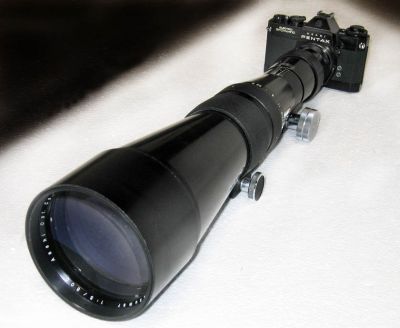
Image 2:
Image 1: Asahi PentaxPentax is a brand name used primarily by Japanese multinational imaging and electronics company Ricoh for 35mm cameras, sport optics, and CCTV optics. Not to be confused with Pentax 6×7 (1969 to 1990) and Pentax 67 (1990 to 1999) which were primarily used for the medium format 120 6x7cm cameras. The Pentax brand is also used by Hoya Corporation for medical products & services, TI Asahi for surveying instruments, and Seiko Optical Products for certain optical lenses. More Electro Spotmatic. Black Spotmatic 35mm SLRA single-lens reflex camera (SLR) is a camera that typically uses a mirror and prism system (hence "reflex" from the mirror's reflection) that permits the photographer to view through the lens and see exactly what will be captured. With twin lens reflex and rangefinder cameras, the viewed image could be significantly different from the final image. When the shutter button is pressed on most SLRs, the mirror flips out of the light path, allowing light to pass through to the film. Other camera typoes include DSLR, Rangefinder and Compact. More camera. Lens: Super Takumar 1.4/50mm. and tripodStand to which the camera can be attached hold it steady, especially during slow exposure shots where camera shake must be avoided. Most tripods have three legs while professionals prefer the more compact but less stable one-legged (mono) versions. More socket.
Image2: Asahi PentaxPentax is a brand name used primarily by Japanese multinational imaging and electronics company Ricoh for 35mm cameras, sport optics, and CCTV optics. Not to be confused with Pentax 6×7 (1969 to 1990) and Pentax 67 (1990 to 1999) which were primarily used for the medium format 120 6x7cm cameras. The Pentax brand is also used by Hoya Corporation for medical products & services, TI Asahi for surveying instruments, and Seiko Optical Products for certain optical lenses. More Electro Spotmatic. Black Spotmatic 35mm SLRA single-lens reflex camera (SLR) is a camera that typically uses a mirror and prism system (hence "reflex" from the mirror's reflection) that permits the photographer to view through the lens and see exactly what will be captured. With twin lens reflex and rangefinder cameras, the viewed image could be significantly different from the final image. When the shutter button is pressed on most SLRs, the mirror flips out of the light path, allowing light to pass through to the film. Other camera typoes include DSLR, Rangefinder and Compact. More camera with Takumar f5/500mm lens, Manual click stop diaphgram, and two-element, rack and pinion focusing, and tripodStand to which the camera can be attached hold it steady, especially during slow exposure shots where camera shake must be avoided. Most tripods have three legs while professionals prefer the more compact but less stable one-legged (mono) versions. More socket. a huge lens. 21″ in length, made by Asahi Kogaku in Japan.
Where to Find a Pentax Spotmatic
Pentax Spotmatic on Etsy
Pentax Spotmatic on Amazon.co.uk
Find a great Pentax Spotmatic on eBay UK
Wiki – Pentax Spotmatic, full range.
PentaxPentax is a brand name used primarily by Japanese multinational imaging and electronics company Ricoh for 35mm cameras, sport optics, and CCTV optics. Not to be confused with Pentax 6×7 (1969 to 1990) and Pentax 67 (1990 to 1999) which were primarily used for the medium format 120 6x7cm cameras. The Pentax brand is also used by Hoya Corporation for medical products & services, TI Asahi for surveying instruments, and Seiko Optical Products for certain optical lenses. More Spotmatic
 | |
| Overview | |
|---|---|
| Maker | Asahi Optical Co |
| Type | SLRA single-lens reflex camera (SLR) is a camera that typically uses a mirror and prism system (hence "reflex" from the mirror's reflection) that permits the photographer to view through the lens and see exactly what will be captured. With twin lens reflex and rangefinder cameras, the viewed image could be significantly different from the final image. When the shutter button is pressed on most SLRs, the mirror flips out of the light path, allowing light to pass through to the film. Other camera typoes include DSLR, Rangefinder and Compact. More |
| Released | 1964 |
| Lens | |
| Lens mount | M42 screw mount |
| Sensor/medium | |
| Sensor type | film |
| Sensor size | 24 x 36 mm |
| Film format | 35 mm |
| Film speed | 20 - 1600 |
| Film speed detection | No |
| Focusing | |
| Focus | Manual focus |
| ExposureThe amount of light that reaches the film (or camera sensor). It determines how light or dark an image is. The exposure of an image is determined by the aperture, shutter speed, and film speed (ISO). During exposure, the sensors or chemicals on the film in analogue models, are subjected to the light outside the camera for a certain time. More/metering | |
| Exposure | Manual exposureThe amount of light that reaches the film (or camera sensor). It determines how light or dark an image is. The exposure of an image is determined by the aperture, shutter speed, and film speed (ISO). During exposure, the sensors or chemicals on the film in analogue models, are subjected to the light outside the camera for a certain time. More |
| Exposure metering | Average, through the lens (TTL) |
| Flash | |
| Flash | FP or X |
| Flash synchronization | 1/60 |
| ShutterEither mechanical and/or electronic shutters are possible. Mechanical systems can use a leaf (or iris) shutter or curtain shutter. In digital cameras a third alternative is also possible: the electronic shutter. This works by activating and then deactivating the CCD so that no further light can be recorded, regardless of whether light is hitting the CCD. The shutter controls the exposure time, which can range from thousandths of a second to several minutes or more. Fast shutter speeds freeze action, slow speeds are more suited to stationary subjects. A tripod is recommended for slow exposure shots to avoid camera shake. More | |
| Shutter | Mechanical |
| Shutter speed range | 1000 - 1 , B |
| Viewfinder | |
| Viewfinder | pentaprism eye-level viewfinder with a microprism focusing screen |
| General | |
| Battery | Earlier model (SP) use RM400 battery; later models use PX625, but 1.5 V silver oxide batteries can be used due to bridge circuit |
| Made in | Japan |
The PentaxPentax is a brand name used primarily by Japanese multinational imaging and electronics company Ricoh for 35mm cameras, sport optics, and CCTV optics. Not to be confused with Pentax 6×7 (1969 to 1990) and Pentax 67 (1990 to 1999) which were primarily used for the medium format 120 6x7cm cameras. The Pentax brand is also used by Hoya Corporation for medical products & services, TI Asahi for surveying instruments, and Seiko Optical Products for certain optical lenses. More Spotmatic refers to a family of 35mm single-lens reflex cameras manufactured by the Asahi Optical Co. Ltd., later known as Pentax Corporation, between 1964 and 1976.
All PentaxPentax is a brand name used primarily by Japanese multinational imaging and electronics company Ricoh for 35mm cameras, sport optics, and CCTV optics. Not to be confused with Pentax 6×7 (1969 to 1990) and Pentax 67 (1990 to 1999) which were primarily used for the medium format 120 6x7cm cameras. The Pentax brand is also used by Hoya Corporation for medical products & services, TI Asahi for surveying instruments, and Seiko Optical Products for certain optical lenses. More Spotmatics used the M42 screw-thread lens mount which was developed after World War II by Zeiss and Praktica. Asahi Optical used the name Takumar for their lenses. These were high-quality, progressively improved lenses, later versions of which featured multi-coating and were called Super Multi Coated Takumars.
The camera used Through The Lens (TTL) light metering, originally it was supposed to be a Spot meter but it ended up being a center-weighted meter. This camera allowed one to focus the lens at maximum apertureThe aperture is basically a hole in the camera’s lens that lets light pass through it to the shutter and ultimately the film or censor. The aperture not only influences picture brightness but also regulates depth of focus. Most cameras are equipped with an iris aperture that can be freely adjusted or set according to pre-selected values. More with a bright viewfinder image. After focusing, a switch on the side of the lens mount stopped the lens down and switched on the metering which the camera displayed with a needle located on the side of the viewfinder. The use of stop-down light metering was at the time revolutionary, but it limited the capability of the lightmeter, especially in low light situations.
Later models Spotmatic F, Electro Spotmatic, ES, and ESII were capable of open-aperture metering when used with Super Multi Coated (S-M-C) Takumar lenses with an apertureThe aperture is basically a hole in the camera’s lens that lets light pass through it to the shutter and ultimately the film or censor. The aperture not only influences picture brightness but also regulates depth of focus. Most cameras are equipped with an iris aperture that can be freely adjusted or set according to pre-selected values. More coupling prong in the lens mount.
Honeywell was the U.S. importer of the Spotmatic. Cameras officially imported by Honeywell were labeled Honeywell PentaxPentax is a brand name used primarily by Japanese multinational imaging and electronics company Ricoh for 35mm cameras, sport optics, and CCTV optics. Not to be confused with Pentax 6×7 (1969 to 1990) and Pentax 67 (1990 to 1999) which were primarily used for the medium format 120 6x7cm cameras. The Pentax brand is also used by Hoya Corporation for medical products & services, TI Asahi for surveying instruments, and Seiko Optical Products for certain optical lenses. More, instead of Asahi PentaxPentax is a brand name used primarily by Japanese multinational imaging and electronics company Ricoh for 35mm cameras, sport optics, and CCTV optics. Not to be confused with Pentax 6×7 (1969 to 1990) and Pentax 67 (1990 to 1999) which were primarily used for the medium format 120 6x7cm cameras. The Pentax brand is also used by Hoya Corporation for medical products & services, TI Asahi for surveying instruments, and Seiko Optical Products for certain optical lenses. More. The Spotmatic IIa was only available as a Honeywell PentaxPentax is a brand name used primarily by Japanese multinational imaging and electronics company Ricoh for 35mm cameras, sport optics, and CCTV optics. Not to be confused with Pentax 6×7 (1969 to 1990) and Pentax 67 (1990 to 1999) which were primarily used for the medium format 120 6x7cm cameras. The Pentax brand is also used by Hoya Corporation for medical products & services, TI Asahi for surveying instruments, and Seiko Optical Products for certain optical lenses. More; it was sold exclusively in the US and had an electronic interface for specific Honeywell Strobonar electronic flash units.
History[edit]
The original 1964 Spotmatic was one of the first SLRsA single-lens reflex camera (SLR) is a camera that typically uses a mirror and prism system (hence "reflex" from the mirror's reflection) that permits the photographer to view through the lens and see exactly what will be captured. With twin lens reflex and rangefinder cameras, the viewed image could be significantly different from the final image. When the shutter button is pressed on most SLRs, the mirror flips out of the light path, allowing light to pass through to the film. Other camera typoes include DSLR, Rangefinder and Compact. More on the market to offer a through-the-lens (TTL) exposureThe amount of light that reaches the film (or camera sensor). It determines how light or dark an image is. The exposure of an image is determined by the aperture, shutter speed, and film speed (ISO). During exposure, the sensors or chemicals on the film in analogue models, are subjected to the light outside the camera for a certain time. More metering system. The camera was presented as a prototype at photokina 1960, and was originally designed to use spot metering. Shortly before production Asahi decided that spot metering would be too difficult to use, and so the metering system was altered to use center-weighted average metering. The change took place too close to production to change the name, and so Spotmatic stuck.[1][2][3][4] The camera had a mechanical shutterEither mechanical and/or electronic shutters are possible. Mechanical systems can use a leaf (or iris) shutter or curtain shutter. In digital cameras a third alternative is also possible: the electronic shutter. This works by activating and then deactivating the CCD so that no further light can be recorded, regardless of whether light is hitting the CCD. The shutter controls the exposure time, which can range from thousandths of a second to several minutes or more. Fast shutter speeds freeze action, slow speeds are more suited to stationary subjects. A tripod is recommended for slow exposure shots to avoid camera shake. More with speed range from 1000 to 1 and BulbBulb mode/setting (B) is a shutter speed option that you can select. It allows your shutter speed to be any length you choose: one second, one minute, 10minutes, etc. It often used to achieve the right exposure for low-light situations like night photography. The Bulb setting usually requires that you hold down the camera’s shutter release button during the entire exposure, or sometimes press it twice. The Bulb name comes from the detachable rubber ‘bulb’ pneumatic shutter releases that were used with early cameras. More. The lightmeter is activated by a lever on the side of the camera, which also stopped down the lens. A Mercury battery (1.35 V Mallory RM640) was used to power the light metering system; however due to the way the circuit is designed, 1.5 V silver oxide batteries can be used instead.[5]
-
Spotmatic face view
-
Spotmatic top view
-
Spotmatic side view
Model range and variations[edit]
The model range includes the original Spotmatic (SP), which had an accessory "cold" shoe for flash
Two budget models: the SP500 and SP1000 were also available and some features from the original Spotmatic were removed. The fastest shutterEither mechanical and/or electronic shutters are possible. Mechanical systems can use a leaf (or iris) shutter or curtain shutter. In digital cameras a third alternative is also possible: the electronic shutter. This works by activating and then deactivating the CCD so that no further light can be recorded, regardless of whether light is hitting the CCD. The shutter controls the exposure time, which can range from thousandths of a second to several minutes or more. Fast shutter speeds freeze action, slow speeds are more suited to stationary subjects. A tripod is recommended for slow exposure shots to avoid camera shake. More speeds were designated by the model number, the SP500 having a top speed of 1/500 s and the SP1000 having a top speed of 1/1000 s. Users discovered the SP500 shutter speedThe time a camera sensor or film is exposed to light when taking a photo. More dial has an unmarked stop where the 1/1000 speed is. These two models had no self-timer. There was also the PentaxPentax is a brand name used primarily by Japanese multinational imaging and electronics company Ricoh for 35mm cameras, sport optics, and CCTV optics. Not to be confused with Pentax 6×7 (1969 to 1990) and Pentax 67 (1990 to 1999) which were primarily used for the medium format 120 6x7cm cameras. The Pentax brand is also used by Hoya Corporation for medical products & services, TI Asahi for surveying instruments, and Seiko Optical Products for certain optical lenses. More SL, which was identical to the Spotmatic except that it did not have the built-in light meter.
The Spotmatic II (SPII) heralded the arrival of the SMC lenses. Among some improvements were better metering system (Max ASA was increased to 3200) and film transport. A hot shoe for flash was added and the synchronization (FP or X) was placed on a dial switch located below the rewind crank.
Spotmatic IIa was made exclusively for the American market. It was made to couple with the Honeywell Strobonar electronic flashes using an electronic eye that was located at the top-left of the camera.
In 1971 the Electro-Spotmatic was the first aperture-priority, electronic, automatic SLRA single-lens reflex camera (SLR) is a camera that typically uses a mirror and prism system (hence "reflex" from the mirror's reflection) that permits the photographer to view through the lens and see exactly what will be captured. With twin lens reflex and rangefinder cameras, the viewed image could be significantly different from the final image. When the shutter button is pressed on most SLRs, the mirror flips out of the light path, allowing light to pass through to the film. Other camera typoes include DSLR, Rangefinder and Compact. More but was only sold in Japan.[6] It success was followed by the ES sold internationally from 1972. The ES had standardized and improved circuitry that addressed reliability issues in the original version.[7] Two years later it was followed by the ES II. Special models could be special ordered with accessories such as Motor Drive, Data Back, etc.
In 1973 the Spotmatic F joined the line. This camera, together with a revamped line of Super Multi Coated (S-M-C) Takumar had the capability of metering without stopping the lens down.
-
Spotmatic IIa
-
Electro Spotmatic
Legacy[edit]
The PentaxPentax is a brand name used primarily by Japanese multinational imaging and electronics company Ricoh for 35mm cameras, sport optics, and CCTV optics. Not to be confused with Pentax 6×7 (1969 to 1990) and Pentax 67 (1990 to 1999) which were primarily used for the medium format 120 6x7cm cameras. The Pentax brand is also used by Hoya Corporation for medical products & services, TI Asahi for surveying instruments, and Seiko Optical Products for certain optical lenses. More Spotmatic chassis was the basis for the PentaxPentax is a brand name used primarily by Japanese multinational imaging and electronics company Ricoh for 35mm cameras, sport optics, and CCTV optics. Not to be confused with Pentax 6×7 (1969 to 1990) and Pentax 67 (1990 to 1999) which were primarily used for the medium format 120 6x7cm cameras. The Pentax brand is also used by Hoya Corporation for medical products & services, TI Asahi for surveying instruments, and Seiko Optical Products for certain optical lenses. More K2, KX, KM and K1000 models with bayonet mount.
Noted users[edit]
Noted users of the PentaxPentax is a brand name used primarily by Japanese multinational imaging and electronics company Ricoh for 35mm cameras, sport optics, and CCTV optics. Not to be confused with Pentax 6×7 (1969 to 1990) and Pentax 67 (1990 to 1999) which were primarily used for the medium format 120 6x7cm cameras. The Pentax brand is also used by Hoya Corporation for medical products & services, TI Asahi for surveying instruments, and Seiko Optical Products for certain optical lenses. More Spotmatic include:
- American poet and photographer Ira Cohen.[8]
- The British band The Beatles (most notably Ringo Starr)
- Australian photographer Carol Jerrems.
References[edit]
- ^ "Classic Cameras – Pentax Spotmatic". Archived from the original on 14 September 2009. Retrieved 10 October 2009.
- ^ "Photoethnography.com - Classic Cameras". www.photoethnography.com.
- ^ "Camera Repair | Canon Repair | Sony Repair".
- ^ "History". Archived from the original on 1 September 2011. Retrieved 1 January 2012.
- ^ Pentax Spotmatic user manual
- ^ "AOHC". Archived from the original on 20 December 2013.
- ^ Cecchi 1990, Asahi PentaxPentax is a brand name used primarily by Japanese multinational imaging and electronics company Ricoh for 35mm cameras, sport optics, and CCTV optics. Not to be confused with Pentax 6×7 (1969 to 1990) and Pentax 67 (1990 to 1999) which were primarily used for the medium format 120 6x7cm cameras. The Pentax brand is also used by Hoya Corporation for medical products & services, TI Asahi for surveying instruments, and Seiko Optical Products for certain optical lenses. More and PentaxPentax is a brand name used primarily by Japanese multinational imaging and electronics company Ricoh for 35mm cameras, sport optics, and CCTV optics. Not to be confused with Pentax 6×7 (1969 to 1990) and Pentax 67 (1990 to 1999) which were primarily used for the medium format 120 6x7cm cameras. The Pentax brand is also used by Hoya Corporation for medical products & services, TI Asahi for surveying instruments, and Seiko Optical Products for certain optical lenses. More SLRA single-lens reflex camera (SLR) is a camera that typically uses a mirror and prism system (hence "reflex" from the mirror's reflection) that permits the photographer to view through the lens and see exactly what will be captured. With twin lens reflex and rangefinder cameras, the viewed image could be significantly different from the final image. When the shutter button is pressed on most SLRs, the mirror flips out of the light path, allowing light to pass through to the film. Other camera typoes include DSLR, Rangefinder and Compact. More 35 mm Cameras 1952–1989, Hove Collectors Books
- ^ "Ira Cohen: psychedelic photography master - in pictures". 13 May 2011 – via www.theguardian.com.
- The Asahi PentaxPentax is a brand name used primarily by Japanese multinational imaging and electronics company Ricoh for 35mm cameras, sport optics, and CCTV optics. Not to be confused with Pentax 6×7 (1969 to 1990) and Pentax 67 (1990 to 1999) which were primarily used for the medium format 120 6x7cm cameras. The Pentax brand is also used by Hoya Corporation for medical products & services, TI Asahi for surveying instruments, and Seiko Optical Products for certain optical lenses. More Way, Herbert Keppler. 11ed 1979. Focal Press.
- Asahi PentaxPentax is a brand name used primarily by Japanese multinational imaging and electronics company Ricoh for 35mm cameras, sport optics, and CCTV optics. Not to be confused with Pentax 6×7 (1969 to 1990) and Pentax 67 (1990 to 1999) which were primarily used for the medium format 120 6x7cm cameras. The Pentax brand is also used by Hoya Corporation for medical products & services, TI Asahi for surveying instruments, and Seiko Optical Products for certain optical lenses. More and PentaxPentax is a brand name used primarily by Japanese multinational imaging and electronics company Ricoh for 35mm cameras, sport optics, and CCTV optics. Not to be confused with Pentax 6×7 (1969 to 1990) and Pentax 67 (1990 to 1999) which were primarily used for the medium format 120 6x7cm cameras. The Pentax brand is also used by Hoya Corporation for medical products & services, TI Asahi for surveying instruments, and Seiko Optical Products for certain optical lenses. More SLRA single-lens reflex camera (SLR) is a camera that typically uses a mirror and prism system (hence "reflex" from the mirror's reflection) that permits the photographer to view through the lens and see exactly what will be captured. With twin lens reflex and rangefinder cameras, the viewed image could be significantly different from the final image. When the shutter button is pressed on most SLRs, the mirror flips out of the light path, allowing light to pass through to the film. Other camera typoes include DSLR, Rangefinder and Compact. More 35mm Cameras 1952–1989, Danilo Cecchi. 2006. MBI Publishing Company.
External links[edit]
![]() Media related to Pentax Spotmatic at Wikimedia Commons
Media related to Pentax Spotmatic at Wikimedia Commons
Post References and Attribution
This post was created with information kindly contributed by Cameras Downunder
Post Links
Used and new camera providers – RW Jemmett Photography Business Directory Film Processing and Supplies

